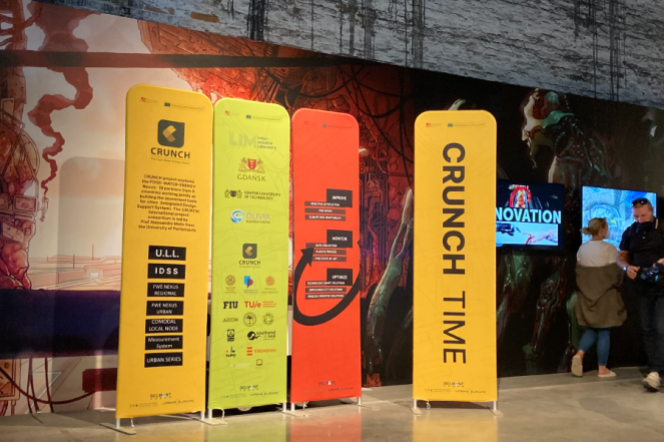Date added: 2021-10-14
Success of Gdańsk urban planners - CRUNCH Time at the Venice Biennale of Architecture

CRUNCH shows how the Food-Water-Energy Nexus (FWE NEXUS) can enhance the resilience of cities. All the cities involved (Portsmouth, Gdańsk, Miami, Taipei, Eindhoven, Uppsala), taking part in experimental laboratories - Urban Living Laboratories, test and analyze solutions in the urban tissue using various scenarios.
The tasks of the international CRUNCH project are carried out in Poland in the Laboratory of Urban Initiatives - a research team established between the City of Gdańsk and Gdańsk University of Technology with the participation of a business partner - Olivia Business Center. Research such as the development of a comparative analysis model, data modeling or case study analysis is conducted mainly at Gdańsk University of Technology and focuses on the classification of Living Laboratories and the scalability of urban solutions for closing the Nexus Food-Water-Energy cycle. The conducted basic research led to the development of the concept of model solutions on an urban scale (FWE NEXUS Neighborhood Model) and a city square scale (FWE Nexus Square). Work is currently underway on the patent applications for the Non-Invasive Measurement System and the Co-modal Neighborhood Node.
The international research team of the CRUNCH project, which includes scientists from Gdańsk University of Technology, presented the results of their research at the prestigious Architecture Biennale in Venice - the most important event in the world of architects in September 2021. The CRUNCH TIME exhibition was organized by Gdańsk University of Technology in the Italian pavilion dedicated to urban resilience. The inauguration was broadcast live on the Resilient Communities Venezia network on social media, which will be available on the YouTube channel of the Italian pavilion after the Biennale closes.
As emphasized by the organizer of the CRUNCH Time exhibition, Joanna Bach Głowińska, PhD, Eng. Arch - manager of the Polish part of the CRUNCH project from Gdańsk University of Technology – Thanks to the involvement and cooperation of the city, science and business environment, we managed to develop a number of innovative solutions in the CRUNCH project.
– We are dealing here not only with the search for innovative theoretical solutions, but above all with testing and implementing them in the context of specific urban spaces - says Prof. Piotr Lorens, Architect of the City of Gdańsk, who accepted the invitation to the CRUNCH Time exhibition and chaired the panel of experts.
Apart from the aforementioned, the opening of the CRUNCH Time exhibition was attended by Prof. Alessandro Melis - project manager and curator of the Italian pavilion and Mei Hua Yuan from National Taiwan University, Thomas Spiegelhalter from Florida International University, Maryam Ghodsvali from Eindhoven University of Technology, Jacek Łubinski, professor at Gdańsk University of Technology and Vera van Zoest from Uppsala University.
The innovative CRUNCH solutions can be replicated in other cities for the benefit of their residents. During the CRUNCH Time exhibition, National Taiwan University presented the FWE NEXUS cross-sector indicators on a global scale. Uppsala University presented an innovative tool of the Integrated Decision Support System (IDSS). The University of Eindhoven showed a city game that transforms the IDSS platform into an attractive form accessible to residents. Florida University showed the possibilities of using IDSS on a regional scale. The Polish side presented FWE NEXUS on the scale of the housing estate and a city square and the assumptions of the Non-invasive Measurement System.
The presented proposals help find ways to build resilience in cities, giving a spark of hope in the reality shown in the Italian Pavilion dedicated to catastrophic visions of the climate crisis. The proposed solutions of the international CRUNCH consortium constructively counteract and help prevent the effects of climate change in cities.

